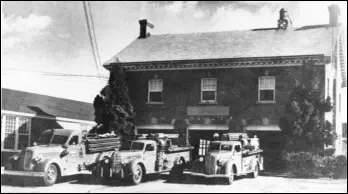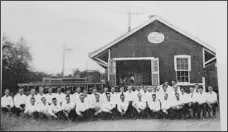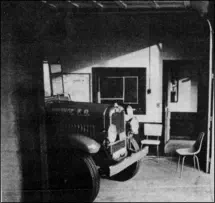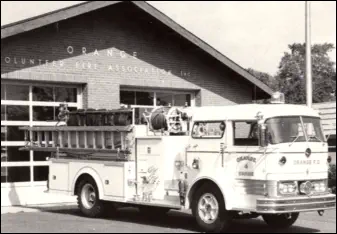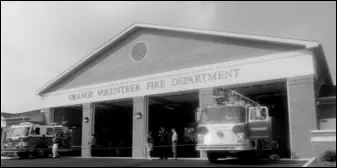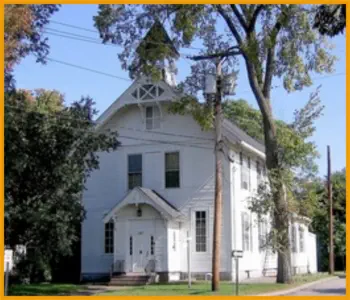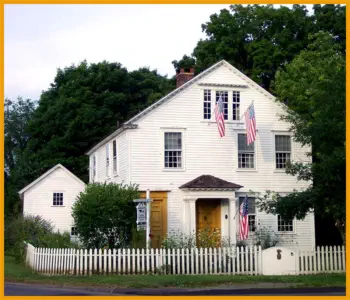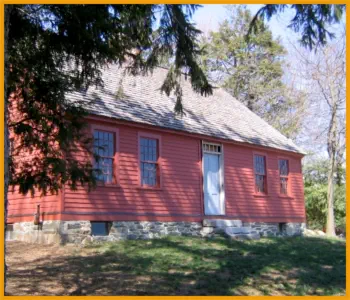



Orange Historical Society


Orange, Connecticut
History

Cold, crisp, clear December nights are not uncommon in Orange.
But the moonlit night of Dec. 30, 1925, witnessed an event that changed how things are done in this town right up until today.
The
moon
was
just
shy
of
being
full
that
night
and
it
likely
reflected
off
the
inch
or
so
of
snow
that
was
already
on
the
ground
as
the
2,000
people
in
this
quiet
farm
town
thought
about
marking
the
end
of
the
year.
The
night’s
peace
was
interrupted
when
the
alarm
sounded,
announcing that Alton Terrell’s Derby Turnpike home was on fire.
The
mansion
on
a
hill
near
today’s
Racebrook
Country
Club
was
fully
ablaze
and
likely
visible
from
a
distance.
There
was
no
fire
department. As word spread, men grabbed their fire buckets and drove, galloped, or ran to the scene for the Sisyphean battle.
The
neighbors
lost
the
fight.
The
mansion
was
destroyed.
Historian
Mary
Woodruff
describes
the
fire
as
the
latest
in
a
series
of
“disastrous fires” that had struck over the past two years. For 14 town residents, it was enough.
Almost
immediately,
14
men
met
to
discuss
creating
a
fire
department.
Just
10
days
after
the
fire
–
on
Jan.
9,
1926
–
they
signed
legal
papers
incorporating
the
Orange
Volunteer
Fire
Association.
The
charter
members
were
James
Beebe,
Benjamin
T.
Clark
Jr.,
George
M.
Curtis
Jr.,
John
R.
Demarest,
John
W.
Gardner,
Clarence
L.
Hall,
Robert
Harris,
Frederick
J.
Hine,
George
J.
Hine,
George
Johnson,
William
A.
Knight,
Chester
S.
Neal,
Donald
Page
and
Alton
T.
Terrell
Jr.
They
chose
officers,
including
William
A.
Knight as chief. He would hold that job until 1944.
The
men
moved
quickly
to
get
the
department
up
and
running.
They
purchased
a
Seagrave
fire
engine
with
1,000
feet
of
hose.
The
railroad
station
on
Orange
Center
Road,
abandoned
since
passenger
service
was
discontinued
a
year
earlier,
was
converted
to
a
firehouse.
Today, a shopping center sits on the site just south of the intersection with Old Grassy Hill Road.
Paying
for
the
continued
operations
and
training
of
the
department
was
a
challenge
that
they
met
with
the
creation
of
a
carnival.
The
first
carnival
was
held
on
the
Town
Green
on
Orange
Center Road in August 1927. There was dancing and prizes donated by local merchants.
The
carnival
has
remained
a
town
staple
and
the
department’s
primary
means
of
funding.
Even
today,
it
underwrites
a
large
part
of
the
state-of-the-art
department’s
operations.
This
year,
2020,
the
carnival
was
canceled
for
only
the
third
time.
The
first
time
it
was
canceled
was
in 1931 because of a polio epidemic. It was also canceled one year during World War II.
By
1935,
the
fire
department
had
outgrown
the
old
fire
station.
With
the
support
of
the
town,
land
on
Orange
Center
Road
was
purchased
from
founding
member
Clark’s
family.
With
help
from the Works Progress Administration, a three-bay firehouse was constructed.
The
equipment
was
no
good
if
people
didn’t
know
there
was
a
fire.
The
first
fire
alarm
system
required
Mrs.
Clara
Code,
chief
operator
of
the local telephone exchange, to ring the party line 10 times and alert the firefighters of the location of the emergency.
By
1938,
the
Southern
New
England
Telephone
Co.
had
absorbed
the
local
system
and
routed
emergency
calls
to
the
two-person
Police
Department.
Humbert
Savastano,
owner
of
the
Paragon
Garage
on
the
Boston
Post
Road,
had
a
telephone
extension
installed
at
the
garage.
He
and
his
son
Arthur
handled
all
the
fire
calls
and
activated
the
sirens
from
1938
to
1950.
They
also
sounded
the
noon
siren.
For
this
work,
they
received
no
compensation.
Today,
firefighters
carry
radio-activated
pagers
that
are
set
off
by
the
dispatcher
as
he
or
she
announces
the
location
of
the
emergency.
In
1960,
the
Boston
Post
Road
was
a
major
thoroughfare
and
the
section
that
ran
through
Orange
was
considered
particularly
unsafe.
Vehicle
accidents
and
business
growth
along
the
highway
made
it
was
clear
that
the
department
needed
to
be
closer.
A
two-bay
firehouse
was
built
on
the
Post
Road.
Around
the
same
time,
an
additional
bay
was
added
to
the
Orange
Center
Road
Station,
and
the
upstairs
meeting rooms were modernized.
Time
passed,
however,
and
the
little
firehouse
along
Route
1
became
obsolete.
In
1996,
plans
were
approved
for
the
four-bay
firehouse
that
today
sits
next
to
the
old
station.
It
houses
apparatus
designed
to
handle
the
industrial
and
multifamily
buildings
in
the
area
and
heavy trucks on nearby Interstate 95. It also has offices, a meeting room, a classroom and exercise areas.
A
regionally
respected,
innovative
and
aggressive
fire
marshal’s
office,
part
of
the
Orange
town
government,
shares
the
firehouse
and
responds with the Fire Department.
Orange
has
grown
from
an
agrarian
hamlet
of
2,000
people
to
a
bustling
community
of
14,000,
intersected
by
major
highways,
railroad
lines
and
under
the
approach
of
busy
airports.
The
Orange
Volunteer
Fire
Department
has
evolved
into
a
state-of-the-art
public
safety
agency
offering
fire
suppression,
light
and
heavy
rescue,
hazardous
materials
response,
public
fire
education
and
things
that
don’t
fall
neatly
into
a
category.
Its
officers
and
firefighters
represent
a
diverse
group
whose
training
meets
or
exceeds
national
standards
and
whose expertise is second to none. An emphasis on education, fitness and training keeps members ready to go.
The
department
is
still
independent,
earning
most
of
its
operating
expenses
from
the
carnival,
the
raffle
and
other
fund-raisers
and
donations.
From
that
first
Seagrave
pumper,
OVFD’s
fleet
has
grown
to
include
three
Class-A
engines,
a
ladder
truck,
a
heavy
rescue,
a
“quint” (combination ladder/pumper), an all-terrain vehicle, a hazmat trailer and two incident command vehicles.
The
future
looks
bright.
The
department
is
keeping
its
fleet
and
its
skills
up
to
date.
Discussions
with
the
town
are
underway
for
a
new
fire station. And young men and women continue to step up to follow in the footsteps of Clark, Knight and Terrell.
Alton
Terrell’s
mansion
is
long
gone.
He
and
the
other
members
of
the
bucket
brigade
would
be
overwhelmed
at
how
Orange
and
the
fire
department
they
created
have
grown.
But
those
14
men
who
signed
that
paperwork
95
years
ago
would
approve
of
how
things
have
turned out.
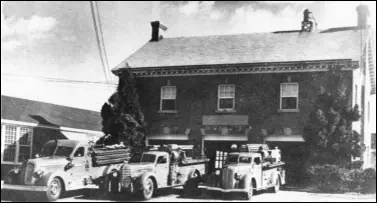
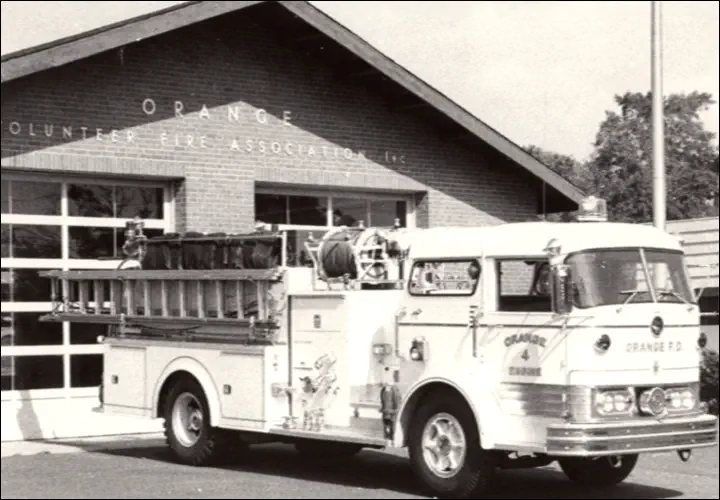
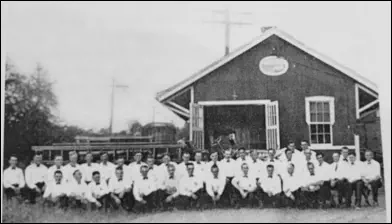
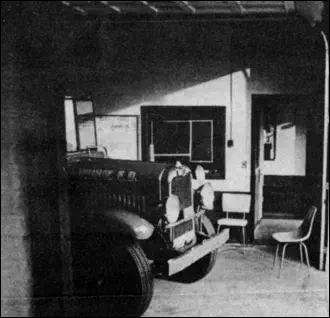













Bryan Andrew









Orange Historical Society
Orange, Connecticut








Bryan Andrew





History
Cold, crisp, clear December
nights are not uncommon in Orange.
But
the
moonlit
night
of
Dec.
30,
1925,
witnessed
an
event
that
changed
how
things
are
done
in
this
town
right
up
until today.
The
moon
was
just
shy
of
being
full
that
night
and
it
likely
reflected
off
the
inch
or
so
of
snow
that
was
already
on
the
ground
as
the
2,000
people
in
this
quiet
farm
town
thought
about
marking
the
end
of
the
year.
The
night’s
peace
was
interrupted
when
the
alarm
sounded,
announcing
that
Alton Terrell’s Derby Turnpike home was on fire.
The
mansion
on
a
hill
near
today’s
Racebrook
Country
Club
was
fully
ablaze
and
likely
visible
from
a
distance.
There
was
no
fire
department.
As
word
spread,
men
grabbed
their
fire
buckets
and
drove,
galloped,
or
ran
to
the scene for the Sisyphean battle.
The
neighbors
lost
the
fight.
The
mansion
was
destroyed.
Historian
Mary
Woodruff
describes
the
fire
as
the
latest
in
a
series
of
“disastrous
fires”
that
had
struck
over
the
past
two years. For 14 town residents, it was enough.
Almost
immediately,
14
men
met
to
discuss
creating
a
fire
department.
Just
10
days
after
the
fire
–
on
Jan.
9,
1926
–
they
signed
legal
papers
incorporating
the
Orange
Volunteer
Fire
Association.
The
charter
members
were
James
Beebe,
Benjamin
T.
Clark
Jr.,
George
M.
Curtis
Jr.,
John
R.
Demarest,
John
W.
Gardner,
Clarence
L.
Hall,
Robert
Harris,
Frederick
J.
Hine,
George
J.
Hine,
George
Johnson,
William
A.
Knight,
Chester
S.
Neal,
Donald
Page
and
Alton
T.
Terrell
Jr.
They
chose
officers,
including
William
A.
Knight
as
chief.
He
would
hold
that
job until 1944.
The
men
moved
quickly
to
get
the
department
up
and
running.
They
purchased
a
Seagrave
fire
engine
with
1,000
feet
of
hose.
The
railroad
station
on
Orange
Center
Road,
abandoned
since
passenger
service
was
discontinued
a
year
earlier,
was
converted
to
a
firehouse.
Today,
a
shopping
center
sits
on
the
site
just
south
of
the
intersection with Old Grassy Hill Road.
Paying
for
the
continued
operations
and
training
of
the
department
was
a
challenge
that
they
met
with
the
creation
of
a
carnival.
The
first
carnival
was
held
on
the
Town
Green
on
Orange
Center
Road
in
August
1927.
There
was
dancing
and
prizes
donated
by
local merchants.
The
carnival
has
remained
a
town
staple
and
the
department’s
primary
means
of
funding.
Even
today,
it
underwrites
a
large
part
of
the
state-of-the-art
department’s
operations.
This
year,
2020,
the
carnival
was
canceled
for
only
the
third
time.
The
first
time
it
was
canceled
was
in
1931
because
of
a
polio
epidemic.
It
was
also canceled one year during World War II.
By
1935,
the
fire
department
had
outgrown
the
old
fire
station.
With
the
support
of
the
town,
land
on
Orange
Center
Road
was
purchased
from
founding
member
Clark’s
family.
With
help
from
the
Works
Progress
Administration, a three-bay firehouse was constructed.
The
equipment
was
no
good
if
people
didn’t
know
there
was
a
fire.
The
first
fire
alarm
system
required
Mrs.
Clara
Code,
chief
operator
of
the
local
telephone
exchange,
to
ring
the
party
line
10
times
and
alert
the
firefighters
of
the
location of the emergency.
By
1938,
the
Southern
New
England
Telephone
Co.
had
absorbed
the
local
system
and
routed
emergency
calls
to
the two-person Police Department.
Humbert
Savastano,
owner
of
the
Paragon
Garage
on
the
Boston
Post
Road,
had
a
telephone
extension
installed
at
the
garage.
He
and
his
son
Arthur
handled
all
the
fire
calls
and
activated
the
sirens
from
1938
to
1950.
They
also
sounded
the
noon
siren.
For
this
work,
they
received
no
compensation.
Today,
firefighters
carry
radio-activated
pagers
that
are
set
off
by
the
dispatcher
as
he
or
she
announces the location of the emergency.
In
1960,
the
Boston
Post
Road
was
a
major
thoroughfare
and
the
section
that
ran
through
Orange
was
considered
particularly
unsafe.
Vehicle
accidents
and
business
growth
along
the
highway
made
it
was
clear
that
the
department
needed
to
be
closer.
A
two-bay
firehouse
was
built
on
the
Post
Road.
Around
the
same
time,
an
additional
bay
was
added
to
the
Orange
Center
Road
Station,
and
the
upstairs
meeting rooms were modernized.
Time
passed,
however,
and
the
little
firehouse
along
Route
1
became
obsolete.
In
1996,
plans
were
approved
for
the
four-bay
firehouse
that
today
sits
next
to
the
old
station.
It
houses
apparatus
designed
to
handle
the
industrial
and
multifamily
buildings
in
the
area
and
heavy
trucks
on
nearby
Interstate
95.
It
also
has
offices,
a
meeting
room,
a
classroom and exercise areas.
A
regionally
respected,
innovative
and
aggressive
fire
marshal’s
office,
part
of
the
Orange
town
government,
shares
the
firehouse
and
responds
with
the
Fire
Department.
Orange
has
grown
from
an
agrarian
hamlet
of
2,000
people
to
a
bustling
community
of
14,000,
intersected
by
major
highways,
railroad
lines
and
under
the
approach
of
busy
airports.
The
Orange
Volunteer
Fire
Department
has
evolved
into
a
state-of-the-art
public
safety
agency
offering
fire
suppression,
light
and
heavy
rescue,
hazardous
materials
response,
public
fire
education
and
things
that
don’t
fall
neatly
into
a
category.
Its
officers
and
firefighters
represent
a
diverse
group
whose
training
meets
or
exceeds
national
standards
and
whose
expertise
is
second
to
none.
An
emphasis
on
education,
fitness
and
training
keeps
members ready to go.
The
department
is
still
independent,
earning
most
of
its
operating
expenses
from
the
carnival,
the
raffle
and
other
fund-raisers
and
donations.
From
that
first
Seagrave
pumper,
OVFD’s
fleet
has
grown
to
include
three
Class-A
engines,
a
ladder
truck,
a
heavy
rescue,
a
“quint”
(combination
ladder/pumper),
an
all-terrain
vehicle,
a
hazmat trailer and two incident command vehicles.
The
future
looks
bright.
The
department
is
keeping
its
fleet
and
its
skills
up
to
date.
Discussions
with
the
town
are
underway
for
a
new
fire
station.
And
young
men
and
women
continue
to
step
up
to
follow
in
the
footsteps
of
Clark, Knight and Terrell.
Alton
Terrell’s
mansion
is
long
gone.
He
and
the
other
members
of
the
bucket
brigade
would
be
overwhelmed
at
how
Orange
and
the
fire
department
they
created
have
grown.
But
those
14
men
who
signed
that
paperwork
95
years ago would approve of how things have turned out.
